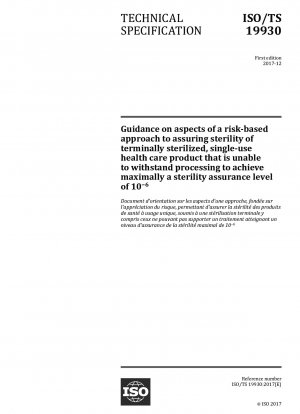ISO/TS 19930:2017
Guidance on aspects of a risk-based approach to assuring sterility of terminally sterilized, single-use health care product that is unable to withstand processing to achieve maximally a sterility assurance level of 10-6
- Standard No.
- ISO/TS 19930:2017
- Release Date
- 2017
- Published By
- International Organization for Standardization (ISO)
- Latest
- ISO/TS 19930:2017
ISO/TS 19930:2017 Referenced Document
- EN 556-1:2001 Sterilization of medical devices - Requirements for medical devices to be designated "STERILE" - Part 1: Requirements for terminally sterilized medical devices*, 2023-12-23 Update
- ISO ISO IEC 27001-2013 cor2-2015 technical errata*, 2023-12-23 Update
- ISO 10993-10:2010 Biological evaluation of medical devices - Part 10: Tests for irritation and skin sensitization
- ISO 10993-11:2017 Biological evaluation of medical devices - Part 11: Tests for systemic toxicity
- ISO 10993-12:2012 Biological evaluation of medical devices - Part 12: Sample preparation and reference materials
- ISO 10993-13:2010 Biological evaluation of medical devices - Part 13: Identification and quantification of degradation products from polymeric medical devices
- ISO 10993-14:2001 Biological evaluation of medical devices - Part 14: Identification and quantification of degradation products from ceramics
- ISO 10993-15:2000 Biological evaluation of medical devices - Part 15: Identification and quantification of degradation products from metals and alloys
- ISO 10993-16:2017 Biological evaluation of medical devices - Part 16: Toxicokinetic study design for degradation products and leachables
- ISO 10993-17:2002 Biological evaluation of medical devices - Part 17: Establishment of allowable limits for leachable substances
- ISO 10993-18:2005 Biological evaluation of medical devices - Part 18: Chemical characterization of materials
- ISO 10993-1:2009 Biological evaluation of medical devices - Part 1: Evaluation and testing within a risk management process
- ISO 10993-2:2006 Biological evaluation of medical devices - Part 2: Animal welfare requirements
- ISO 10993-3:2014 Biological evaluation of medical devices - Part 3: Tests for genotoxicity, carcinogenicity and reproductive toxicity
- ISO 10993-4:2017 Biological evaluation of medical devices - Part 4: Selection of tests for interactions with blood
- ISO 10993-5:2009 Biological evaluation of medical devices — Part 5: Tests for cytotoxicity: in vitro methods
- ISO 10993-6:2016 Biological evaluation of medical devices - Part 6: Tests for local effects after implantation
- ISO 10993-7:2008 Biological evaluation of medical devices - Part 7: Ethylene oxide sterilization residuals
- ISO 10993-9:2009 Biological evaluation of medical devices - Part 9: Framework for identification and quantification of potential degradation products
- ISO 11135-1:2007 Sterilization of health care products - Ethylene oxide - Part 1: Requirements for development, validation and routine control of a sterilization process for medical devices
- ISO 11137-1:2006 Sterilization of health care products - Radiation - Part 1: Requirements for development, validation and routine control of a sterilization process for medical devices
- ISO 11137-2:2013 Sterilization of health care products - Radiation - Part 2: Establishing the sterilization dose
- ISO 9000:2005 Quality management systems - Fundamentals and vocabulary
- ISO 9001:2015 Quality management systems - Requirements
- ISO 9004:2009 Managing for the sustained success of an organization - A quality management approach
- ISO/IEC GUIDE 51:2014 Safety aspects - Guidelines for their inclusion in standards
ISO/TS 19930:2017 history
- 2017 ISO/TS 19930:2017 Guidance on aspects of a risk-based approach to assuring sterility of terminally sterilized, single-use health care product that is unable to withstand processing to achieve maximally a sterility assurance level of 10-6
